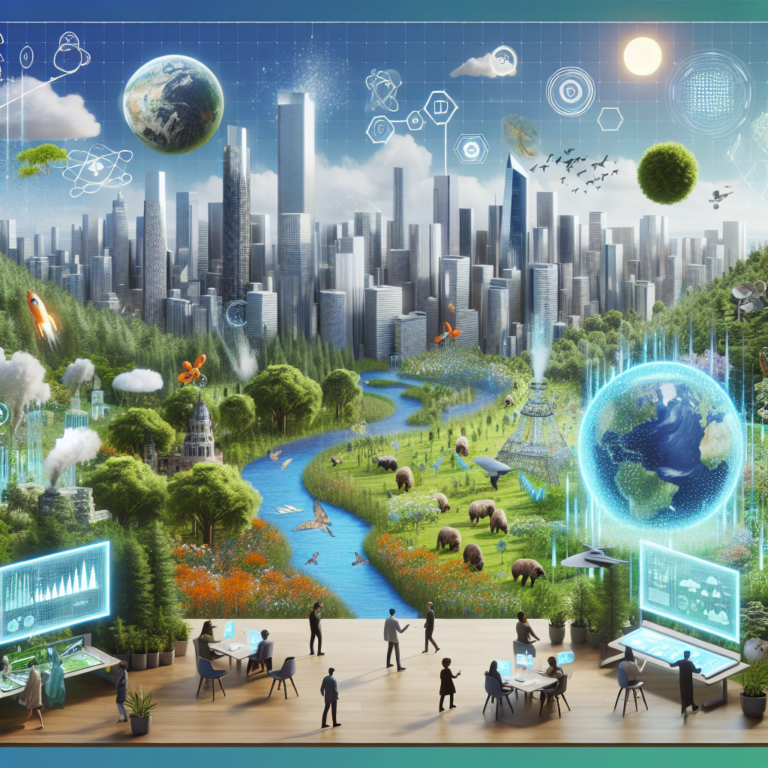Unlocking the Potential of Real-Time Climate Change Simulations in the Metaverse 🌍
Introduction: The Intersection of the Metaverse and Climate Action
Imagine stepping into a virtual world where the complexities of climate change unfold before your eyes. The metaverse, a digital universe connecting users through immersive experiences, holds the potential to revolutionize how policy makers approach climate change. With real-time simulations that visualize the impact of environmental policies, we could empower leaders to make informed decisions. Let’s explore how the metaverse can transform climate strategy, and what this means for our planet.
Understanding the Metaverse: A Game Changer for Climate Policy
To appreciate the significant role the metaverse can play in climate change simulations, it’s essential to comprehend what the metaverse truly represents. A virtual reality space where users interact with a computer-generated environment and other users, the metaverse can be tailored to simulate complex scenarios in real time. Here are some exciting aspects:
- Interactive Visualization: Users can explore 3D environments that showcase different climate scenarios based on real-time data.
- Engagement of Stakeholders: Policy makers can engage with scientists, environmentalists, and the public in an immersive setting.
- Data Analysis: Integrated AI can analyze data and project outcomes based on various policy options.
The Power of Real-Time Simulations
Real-time climate change simulations in the metaverse present a myriad of benefits for policy makers aiming for effective solutions. Here’s how these dynamic tools can reshape environmental initiatives:
1. Visualizing Future Scenarios
With 3D modeling, leaders can experience potential futures of our planet based on current trends. They can visualize:
- Changes in sea levels due to melting ice caps
- The impact of deforestation on biodiversity
- Urban heat islands and their effect on communities
These vivid representations can prompt urgent discussions about necessary policy changes.
2. Scenario Planning and Policy Testing
Imagine a space where multiple policy options can be tested simultaneously! In the metaverse, policies can be slotted into the simulation to see their potential effects. This allows policy makers to:
- Identify successful initiatives before implementation
- Spot unforeseen consequences and adapt accordingly
- Collaborate in real-time with scientists and communities
3. Engaging the Public and Decision Makers
A significant hurdle in climate action is translating complex scientific data for public understanding. The metaverse allows for:
- Interactive Workshops: Experts can conduct workshops where participants simulate different events.
- Stakeholder Collaboration: Policymakers can invite community voices to the table, strengthening democracy and inclusivity.
By involving the public, we can foster a more significant community commitment to climate initiatives.
Benefits for Policy Makers
Integrating real-time climate change simulations into the policy-making process provides an array of advantages:
1. Data-Driven Decision Making
With the metaverse, data becomes more than just numbers; it’s transformed into a visual narrative. This situation provides:
- Immediate Feedback: Instant tracking of simulated outcomes allows for rapid adjustments.
- Informed Choices: Policy makers can easily assess the long-term consequences of specific actions.
2. Building Consensus
Finding a middle ground among stakeholders can often be a challenge. The metaverse fosters a collaborative environment:
- Visual Storytelling: It allows for shared experiences that emphasize the urgency of climate actions.
- Pilot Programs: Simulations can serve as pilot programs, demonstrating to stakeholders the efficacy of proposed solutions.
3. Educational Opportunities
Much of the struggle with climate policies is rooted in misinformation or lack of understanding. The metaverse serves as a rich educational platform:
- Virtual Learning Experiences: Policy makers can educate themselves and their teams about climate science and effective strategies.
- Access to Resources: A wealth of materials and expert insights can be made available within the virtual space.
The Role of Technology in Climate Action
To leverage the metaverse fully, we must implement advanced technologies that support these simulations. Some critical components include:
1. Artificial Intelligence
AI can enhance simulations by predicting outcomes based on user-input policies. This technology can:
- Analyze Historical Data: AI can identify trends and patterns in historic climate data.
- Predict Future Impacts: With machine learning algorithms, AI can suggest the likely outcomes of specific actions.
2. Big Data Analytics
Managing and processing vast amounts of climate data is crucial. Big data can:
- Identify Key Variables: Which factors most influence climate change can be assessed.
- Optimize Policies: Tailor solutions based on a comprehensive analysis of large datasets.
3. Virtual Reality and Augmented Reality
The immersive experiences provided by VR and AR can enhance user engagement and understanding. These technologies enable:
- Real-World Interactions: Users can experience climate change impacts in real-time.
- Practical Applications: The possibility of walking through a forest or city that depicts the effects of climate actions enhances empathy and urgency.
Conclusion: A Call to Action for Visionary Leaders
As we stand on the brink of a climate crisis, integrating the metaverse into our climate strategies can provide significant advantages. By simulating the effects of policies in real time, we can create more informed, engaged, and proactive leaders in the fight against climate change. The future is digital, and the pathway to effective climate action might just lie in this immersive realm. 🌱




0 Comments